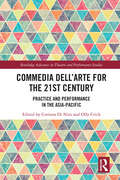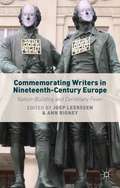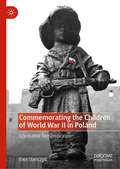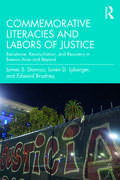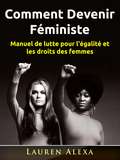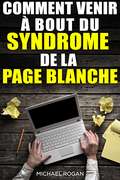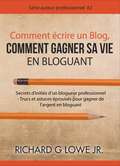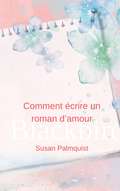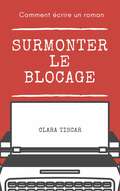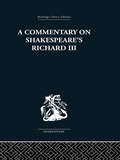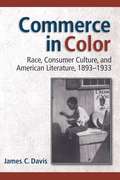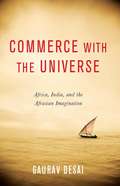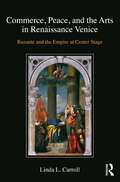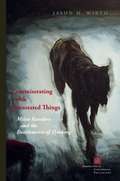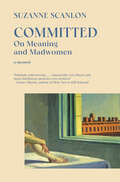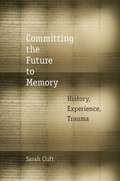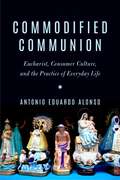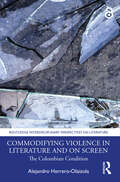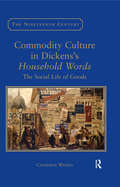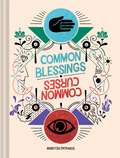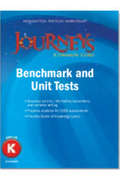- Table View
- List View
Commedia dell’Arte for the 21st Century: Practice and Performance in the Asia-Pacific (Routledge Advances in Theatre & Performance Studies)
by Olly Crick Corinna Di NiroThis book discusses the evolution of Commedia dell’Arte in the Asia-Pacific where through the process of reinvention and recreation it has emerged as a variety of hybrids and praxes, all in some ways faithful to the recreated European genre. The contributors in this collection chart their own training in the field and document their strategies for engaging with this form of theatre. In doing so, this book examines the current thoughts, ideas, and perceptions of Commedia – a long-standing theatre genre, originating in a European-based collision between neo-classical drama and oral tradition. The contributing artists, directors, teachers, scholars and theatre-makers give insight into working styles, performance ideas, craft techniques and ways to engage an audience for whom Commedia is not part of their day-to-day culture. The volume presents case studies by current practitioners, some who have trained under known Commedia ‘masters’ (e.g. Lecoq, Boso, Mazzone-Clementi and Fava) and have returned to their country of origin where they have developed their performance and teaching praxis, and others (e.g. travelling from Europe to Japan, Thailand, Singapore and China) who have discovered access points to share or teach Commedia in places where it was previously not known. This book will be of great interest to students and scholars in Performing arts, Italian studies, and History as well as practitioners in Commedia dell’Arte.
Commemorating Writers in Nineteenth-Century Europe
by Joep Leerssen Ann RigneyThis volume offers detailed accounts of the cults of individual writers and a comparative perspective on the spread of centenary fever across Europe. It offers a fascinating insight into the interaction between literature and cultural memory, and the entanglement between local, national and European identities at the highpoint of nation-building.
Commemorating the Children of World War II in Poland: Combative Remembrance
by Ewa StańczykThis book explores contemporary debates surrounding Poland’s 'war children', that is the young victims, participants and survivors of the Second World War. It focuses on the period after 2001, which saw the emergence of the two main political parties that were to dictate the tone of the politics of memory for more than a decade. The book shows that 2001 marked a caesura in Poland’s post-Communist history, as this was when the past took center stage in Polish political life. It argues that during this period a distinct culture of commemoration emerged in Poland – one that was not only governed by what the electorate wanted to hear and see, but also fueled by emotions.
Commemorative Literacies and Labors of Justice: Resistance, Reconciliation, and Recovery in Buenos Aires and Beyond
by Loren D. Lybarger James S. Damico Edward BrudneyThis book examines literacy practices of commemoration marking the 40th anniversary of the March 24, 1976 coup in Argentina. Drawing on research conducted across three distinct sites in Buenos Aires in March 2016—a public university, a Catholic church, and a former naval base and clandestine detention center transformed into a museum space for memory and justice—this book sheds light on the ways commemorative literacies at these locations work spatially to mobilize memory of the past to address and advance justice concerns in the present. These labors of justice manifest in three ways: as resistance, reconciliation, and recovery. Damico, Lybarger, and Brudney also demonstrate how these particular kinds of commemorative literacies resonate transnationally in ways that necessitate a commitment to commemorative ethics. This book is ideal not only for researchers, graduate students, and scholars in literacy studies but also for all those working in related fields, including memory studies, religious studies, area studies, and Latin American studies, to address issues pertaining to memory, testimony, transitional justice, state repression, and human rights in Argentina, Latin America, or the Global South, more generally.
Comment Devenir Féministe: Manuel de lutte pour l'égalité et les droits des femmes
by Lauren AlexaAvez-vous déjà été victime de violence, de harcèlement ou de discrimination à cause de votre sexe ? Avez-vous déjà été témoin de discrimination envers des femmes ? En devenant féministe, vous lutterez pour des choses qui comptent réellement, telles que l’égalité des salaires, le respect, les congé maternité, le droit à la reproduction, contre la violence conjugale, etc. Si vous voulez en savoir plus sur la lutte pour le droit des femmes dans le monde et sur la manière dont vous pouvez contribuer à ce combat, ce guide est fait pour vous. -Apprenez à devenir féministe -Apprenez à vous battre pour les droits des femmes -Luttez pour l’égalité des salaires -Et bien plus encore ! Devenez féministe et aider l’humanité là où elle a le plus besoin de vous ! L’auteur et le(s) propriétaire(s) des droits d’auteur ne peuvent garantir l’exactitude, l’exhaustivité ou la pertinence du contenu de ce livre et déclinent expressément toute responsabilité en cas d’erreur ou d’omission. Ce produit a vocation de référence. Merci de consulter un professionnel avant de prendre une quelconque décision suite à la lecture de ce livre.
Comment venir à bout du syndrome de la page blanche
by Marie-Agnès Benoit Michael RoganDécouvrez comment venir à bout du syndrome de la page blanche (pour de bon). Vous en avez assez qu'on vous dise « continuez à écrire et tout rentrera dans l'ordre »? Vous cherchez un moyen d’éliminer pour de bon le blocage qui vous empêche de terminer ce gros projet sur lequel vous travaillez depuis des années? Vous voulez des trucs honnêtes, ultra simples et super pratiques qui vous aideront à cesser de douter de vous-même et à devenir l'incroyable auteur que vous pensez être? Et bien, « Comment venir à bout du syndrome de la page blanche » vous fera découvrir : • Comment modifier votre cerveau pour maximiser votre performance d’écrivain • Comment faire taire votre critique intérieure • Comment créer un repaire pour écrire sans distraction • Comment devenir accro à l'écriture (sans efforts) • Comment finir ce que vous avez commencé (à chaque fois) …et beaucoup plus! Chaque chapitre contient des étapes faciles à suivre qui vous aideront à vaincre le syndrome de la page blanche (pour de bon) - sans que vous ayez à suivre un seul atelier New Age! Alors, pourquoi ne pas commencer à combattre votre syndrôme de la page blanche...aujourd'hui même!
Comment écrire un Blog, Comment gagner sa vie en Bloguant
by Richard G Lowe Jr Laura DinrathsC’est un art d’écrire un article qui encourage le lecteur à prendre la décision d’agir. Voici la vision étroite du livre que vous lisez en ce moment sur votre Kindle. Vous apprendrez à créer un article qui intéresse le lecteur, l’interpelle, l’informe, et l’entraîne à prendre une décision à la fin de sa lecture. Le livre que vous lisez pour le moment décrit la méthode que j’utilise pour créer des articles de blogs dont l’intention spécifique est de pousser le lecteur du moment où il clique sur le lien jusqu’à ce qu’il clique sur le bouton ‘acheter’ ou ‘souscrire’ au bas de la page. Vous apprendez : * Comment créer un titre qui attire des lecteurs vers votre article * Quoi inclure au-dessus de la ligne de flottaison * Comment ajouter des déclencheurs émotionnels * Comment pousser vos lecteurs à partager votre article * Quelles autres informations inclure dans le texte * Comment les pousser à cliquer sur ‘acheter’ * L’importance des bonnes images * L’intérêt des vidéos
Comment écrire un roman d’amour
by Susan PalmquistAvez-vous déjà rêvé d’écrire un roman d’amour ? Dans cette deuxième édition de Comment écrire un roman d’amour, vous apprendrez des trucs et astuces pour commencer votre histoire, la terminer et la soumettre à un éditeur ou un agent. Vous apprendrez comment trouver des idées pour des histoires, comment planifier votre roman, l’importance des trois premiers chapitres, comment créer une intrigue, comment augmenter l’émotion dans votre histoire, comment créer des personnages et des dialogues pour éveiller l’intérêt de votre lecteur, comment créer une tension sexuelle, comment préparer votre soumission de manuscrit pour qu’il soit remarqué, les endroits où vous pouvez soumettre des histoires d’amour, des suggestions d’écriture pour lancer le processus de création et inviter la muse. Si vous avez toujours voulu apprendre le métier d’écriture romantique, mais n’avez pas eu le temps ou le budget pour profiter d’un atelier, ce livre vous offre tout ce qu’il faut pour commencer.
Comment écrire un roman: Surmonter le blocage
by Sophie Martin Clara TiscarVous avez envie d’écrire ? Vous avez déjà eu l’impression d’être bloqué ? Vivez-vous l’angoisse de la page blanche ? Ce livre est fait pour vous si vous vous reconnaissez dans l’une des situations suivantes : ✓ J’ai envie d’écrire, mais je ne trouve pas le moment de le faire. ✓ Je suis bloqué, je ne sais pas comment continuer mon roman. ✓ Je sais quelle histoire je souhaite raconter, mais je n’arrive pas à l’écrire. ✓ Je ne suis pas vraiment bloqué, mais je manque de motivation pour continuer d’écrire mon roman. Conçu comme un guide de référence pratique et interactif, cet ouvrage vous offre méthodes et ressources pour surmonter l'angoisse de la page blanche et éviter le blocage de l'écrivain.
Commentary on Shakespeare's Richard III
by Wolfgang ClemenFirst published in 1968. Providing a detailed and rigorous analysis of Richard III, this Commentary reveals every nuance of meaning whilst maintaining a firm grasp on the structure of the play. The result is an outstanding lesson in the methodology of Shakespearian criticism as well as an essential study for students of the early plays of Shakespeare.
Commerce in Color: Race, Consumer Culture, and American Literature, 1893-1933
by James C. DavisCommerce in Color explores the juncture of consumer culture and race by examining advertising, literary texts, mass culture, and public events in the United States from 1893 to 1933. James C. Davis takes up a remarkable range of subjects—including the crucial role publishers Boni and Liveright played in the marketing of Harlem Renaissance literature, Henry James’s critique of materialism in The American Scene, and the commodification of racialized popular culture in James Weldon Johnson’s The Autobiography of an Ex-Colored Man—as he argues that racial thinking was central to the emergence of U.S. consumerism and, conversely, that an emerging consumer culture was a key element in the development of racial thinking and the consolidation of racial identity in America. By urging a reassessment of the familiar rubrics of the “culture of consumption” and the “culture of segregation,” Dawson poses new and provocative questions about American culture and social history.
Commerce with the Universe
by Gaurav DesaiReading the life narratives and literary texts of South Asians writing in East Africa, Gaurav Desai builds a new history of Africa's encounter with slavery, colonialism, migration, nationalism, development, and globalization. Rather than approach literature and culture from a nation-centered perspective, Desai connects the medieval trade routes of the Islamicate empire, the early independence movements galvanized in part by Gandhi's southern African experiences, the invention of new ethnic nationalisms, and the rise of plural, multiethnic nations to the fertile exchange taking place across the Indian Ocean.
Commerce with the Universe: Africa, India, and the Afrasian Imagination
by Gaurav DesaiReading the life narratives and literary texts of South Asians writing in and about East Africa, Gaurav Desai builds a surprising, alternative history of Africa's experience with slavery, migration, colonialism, nationalism, and globalization. Consulting Afrasian texts that are literary and nonfictional, political and private, he broadens the scope of African and South Asian scholarship and inspires a more nuanced understanding of the Indian Ocean's fertile routes of exchange.Desai shows how the Indian Ocean engendered a number of syncretic identities and shaped the medieval trade routes of the Islamicate empire, the early independence movements galvanized in part by Gandhi's southern African experiences, the invention of new ethnic nationalisms, and the rise of plural, multiethnic African nations. Calling attention to lives and literatures long neglected by traditional scholars, Desai introduces rich, interdisciplinary ways of thinking not only about this specific region but also about the very nature of ethnic history and identity. Traveling from the twelfth century to today, he concludes with a look at contemporary Asian populations in East Africa and their struggle to decide how best to participate in the development and modernization of their postcolonial nations without sacrificing their political autonomy.
Commerce, Peace, and the Arts in Renaissance Venice: Ruzante and the Empire at Center Stage
by Linda L. CarrollWith the Paduan playwright Angelo Beolco, aka Ruzante, as a focal point, this book sheds new light on his oeuvre and times - and on Venetian patrician interest in him - by embedding the Venetian aspects of his life within the monumental changes taking place in fifteenth- and sixteenth-century Venice, politically, economically, socially, and artistically. In a study of patronage in the broadest sense of the term, Linda Carroll draws on vast quantities of new archival information; and by reading the previously unpublished primary sources against each other, she uncovers remarkable and heretofore unsuspected coincidences and connections. She documents the well-known links between the increasingly fruitless trade to the north and the need for new investments in land (re)gained by Venice on the mainland, links between problems of governance and political networks. She unveils the significance and potential purposes of those who invited Ruzante to perform in what are interpreted as "rudely" metaphorical truth-telling plays for Venetians at the highest social and political levels. Focusing on a group of patrons of art works in S. Maria Gloriosa dei Frari, the first chapter establishes their numerous interrelated commercial and political interests and connects them to the content of the works and artists chosen to execute them. The second chapter demonstrates the economic interests and related political tensions that lay behind the presence of many high-ranking government officials at a scandalous 1525 Ruzante performance. It also draws on these and materials concerning previous generations of the Beolco family and Venetian patricians to provide an entirely new picture of Beolco's relationships with his Venetian supporters. The third chapter analyzes an important Venetian literary manuscript of the period in the Bodleian Library of Oxford University whose copyist had remained unknown and whose contents have been little studied. The identity of the copyist, a central figure in the worlds of theatrical and historical and, now, literary writing in early sixteenth century Venice, is clarified and the works in the manuscript connected to the cultural worlds of Venice, Padua and Rome.
Commiserating with Devastated Things: Milan Kundera and the Entitlements of Thinking (Perspectives in Continental Philosophy)
by Jason M. WirthCommiserating with Devastated Things seeks to understand the place Milan Kundera calls “the universe of the novel.” Working through Kundera’s oeuvre as well as the continental philosophical tradition, Wirth argues that Kundera transforms—not applies—philosophical reflection within literature.Reading between Kundera’s work and his self-avowed tradition, from Kafka to Hermann Broch, Wirth asks what it might mean to insist that philosophy does not have a monopoly on wisdom, that the novel has its own modes of wisdom that challenge philosophy’s.
Committed: On Meaning and Madwomen
by Suzanne ScanlonA raw and masterful memoir about becoming a woman and going mad—and doing both at once. When Suzanne Scanlon was a student at Barnard in the 90s, grieving the loss of her mother—feeling untethered and swimming through inarticulable pain—she made a suicide attempt that landed her in the New York State Psychiatric Institute. After nearly three years and countless experimental treatments, Suzanne left the ward on shaky legs. In the decades it took her to recover from the experience, Suzanne came to understand her suffering as part of something larger: a long tradition of women whose complicated and compromised stories of self-actualization are reduced to &“crazy chick&” and &“madwoman&” narratives. It was a thrilling discovery, and she searched for more books, more woman writers, as the journey of her life converged with her journey through the literature that shaped her. Transporting, honest, and graceful, Committed is a story of discovery and recovery, reclaiming the idea of the madwoman as a template for insight and transcendence through the works of Charlotte Perkins Gilman, Virginia Woolf, Sylvia Plath, Janet Frame, Audre Lorde, Shulamith Firestone, and others.
Committing the Future to Memory: History, Experience, Trauma
by Sarah CliftWhereas historical determinacy conceives the past as a complex and unstable network of causalities, this book asks how history can be related to a more radical future. To pose that question, it does not reject determinacy outright but rather seeks to explore how it works. In examining what it means to be “determined” by history, it also asks what kind of openings there might be in our encounters with history for interruptions, re-readings, and re-writings.Engaging texts spanning multiple genres and several centuries—from John Locke to Maurice Blanchot, from Hegel to Benjamin—Clift looks at experiences of time that exceed the historical narration of experiences said to have occurred in time. She focuses on the co-existence of multiple temporalities and opens up the quintessentially modern notion of historical succession to other possibilities. The alternatives she draws out include the mediations of language and narration, temporal leaps, oscillations and blockages, and the role played by contingency in representation. She argues that such alternatives compel us to reassess the ways we understand history and identity in a traumatic, or indeed in a post-traumatic, age.
Commodified Communion: Eucharist, Consumer Culture, and the Practice of Everyday Life
by Antonio Eduardo AlonsoWINNER, 2021 HTI BOOK PRIZEResist! This exhortation animates a remarkable range of theological reflection on consumer culture in the United States. And for many theologians, the source and summit of Christian cultural resistance is the Eucharist. In Commodified Communion, Antonio Eduardo Alonso calls into question this dominant mode of theological reflection on contemporary consumerism. Reducing the work of theology to resistance and centering Christian hope in a Eucharist that might better support it, he argues, undermines our ability to talk about the activity of God within a consumer culture. By reframing the question in terms of God’s activity in and in spite of consumer culture, this book offers a lived theological account of consumer culture that recognizes not only its deceptions but also traces of truth in its broken promises and fallen hopes.
Commodifying Violence in Literature and on Screen: The Colombian Condition (Routledge Interdisciplinary Perspectives on Literature)
by Alejandro Herrero-OlaizolaThis book traverses the cultural landscape of Colombia through in-depth analyses of displacement, local and global cultures, human rights abuses, and literary and media production. Through an exploration of the cultural processes that perpetuate the "darker side" of Latin America for global consumption, it investigates the "condition" that has led writers, filmmakers, and artists to embrace (purposefully or not) the incessant violence in Colombian society as the object of their own creative endeavors. In this examination of mass-marketed cultural products such as narco-stories, captivity memoirs, gritty travel narratives, and films, Herrero-Olaizola seeks to offer a hemispheric approach to the role played by Colombia in cultural production across the continent where the illicit drug trade has made significant inroads. To this end, he identifies the "Colombian condition" within the parameters of the global economy while concentrating on the commodification of Latin America’s violence for cultural consumption.
Commodity Culture in Dickens's Household Words: The Social Life of Goods (The Nineteenth Century Series)
by Catherine WatersIn 1850, Charles Dickens founded Household Words, a weekly miscellany intended to instruct and entertain an ever-widening middle-class readership. Published in the decade following the Great Exhibition of 1851, the journal appeared at a key moment in the emergence of commodity culture in Victorian England. Alongside the more well-known fiction that appeared in its pages, Dickens filled Household Words with articles about various commodities-articles that raise wider questions about how far society should go in permitting people to buy and sell goods and services: in other words, how far the laissez-faire market should extend. At the same time, Household Words was itself a commodity. With marketability clearly in view, Dickens required articles for his journal to be 'imaginative,' employing a style that critics ever since have too readily dismissed as mere mannerism. Locating the journal and its distinctive handling of non-fictional prose in relation to other contemporary periodicals and forms of print culture, this book demonstrates the role that Household Words in particular, and the Victorian press more generally, played in responding to the developing world of commodities and their consumption at midcentury.
Common Blessings, Common Curses
by Maritsa PatrinosCommon Blessings / Common Curses is a lighthearted reversible book that explores the ups and downs of day-to-day life.Read it upright for modern-day blessings, or flip it upside down for contemporary curses.Blessings include waking up to good hair days or having enough change for laundry, while curses include burning your tongue on hot pizza or losing your sneeze. What will today bring?• Filled with vibrant illustrations by popular webcomic illustrator Maritsa Patrinos• Highly relatable no matter what kind of day you had• Based on an Ignatz Award-nominated comic seriesCelebrate the sympathetically funny moments that can make or break your day.The oh-so-relatable Common Blessings / Common Curses marries mindfulness with a dose of reality.• Makes a perfect gift for millennials, college students, graduates, and anyone experiencing the highs and lows of life• A playful take on modern life and the frustrations (and joys!) that can ensue• Great for those who loved reading oh no by Alex Norris, Adulthood is a Myth: A Sarah's Scribbles Collection by Sarah Andersen, and Strange Planetby Nathan W. Pyle
Common Blessings, Common Curses
by Maritsa PatrinosCommon Blessings / Common Curses is a lighthearted reversible book that explores the ups and downs of day-to-day life.Read it upright for modern-day blessings, or flip it upside down for contemporary curses.Blessings include waking up to good hair days or having enough change for laundry, while curses include burning your tongue on hot pizza or losing your sneeze. What will today bring?• Filled with vibrant illustrations by popular webcomic illustrator Maritsa Patrinos• Highly relatable no matter what kind of day you had• Based on an Ignatz Award-nominated comic seriesCelebrate the sympathetically funny moments that can make or break your day.The oh-so-relatable Common Blessings / Common Curses marries mindfulness with a dose of reality.• Makes a perfect gift for millennials, college students, graduates, and anyone experiencing the highs and lows of life• A playful take on modern life and the frustrations (and joys!) that can ensue• Great for those who loved reading oh no by Alex Norris, Adulthood is a Myth: A Sarah's Scribbles Collection by Sarah Andersen, and Strange Planetby Nathan W. Pyle
Common Blessings, Common Curses
by Maritsa PatrinosCommon Blessings / Common Curses is a lighthearted reversible book that explores the ups and downs of day-to-day life.Read it upright for modern-day blessings, or flip it upside down for contemporary curses.Blessings include waking up to good hair days or having enough change for laundry, while curses include burning your tongue on hot pizza or losing your sneeze. What will today bring?• Filled with vibrant illustrations by popular webcomic illustrator Maritsa Patrinos• Highly relatable no matter what kind of day you had• Based on an Ignatz Award-nominated comic seriesCelebrate the sympathetically funny moments that can make or break your day.The oh-so-relatable Common Blessings / Common Curses marries mindfulness with a dose of reality.• Makes a perfect gift for millennials, college students, graduates, and anyone experiencing the highs and lows of life• A playful take on modern life and the frustrations (and joys!) that can ensue• Great for those who loved reading oh no by Alex Norris, Adulthood is a Myth: A Sarah's Scribbles Collection by Sarah Andersen, and Strange Planetby Nathan W. Pyle
